Many people would like straighter teeth but not everybody feels comfortable wearing conspicuous metal braces.
Ceramic braces are a popular orthodontics alternative since they are just as effective but much less noticeable. You might also consider clear aligners – which are almost invisible – for your treatment.
In this guide, we explain what makes ceramic fixed braces different from other types of brace, what options are available in the US, and how much they cost. We hope you find all the information you need to make up your mind about whether this is the right type of brace for you.
What are ceramic braces?
Think traditional metal braces, only made from a white or clear material so they’re less obvious. Fixed ceramic brackets are bonded to each tooth and connected with an archwire. Sometimes the wire is also tooth-colored (or ‘frosted’) so the entire appliance blends in with the teeth. Small elastic bands called ‘ligatures’ hold the wire in place on each bracket – and they are usually the same color as the brackets as well.
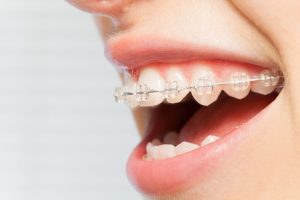

During orthodontic treatment, you will need to have checkups every 6-10 weeks. At these visits, your orthodontist will check the progress of your treatment and make adjustments to the wire to keep your teeth moving in the right direction. Total treatment time is usually around 18-24 months but this depends on the amount of correction needed.
Patients often find their teeth are a little sore for a day or two after their braces are tightened, but aside from that, there should be minimal discomfort.
Some ceramic braces use self-ligating technology. This allows the wire to automatically tighten and adjust itself, making the treatment process smoother on the teeth. It also means that no ligatures are needed since the brackets themselves clasp the wire.
Ceramic fixed braces come with a range of benefits:
- Discreet way to straighten teeth
- Suitable for both teenagers and adults
- Can treat a wide variety of teeth alignment problems, including severe malocclusion, like underbite and overbite teeth
- The ceramic material is strong and won’t chip or break easily
Many people undergo orthodontic work because they feel self-conscious about their uneven teeth. But as well as the aesthetic benefits, straighter teeth are easier to clean. So any investment in braces is also an investment in your oral hygiene for the future.
Ceramic braces vs. metal braces
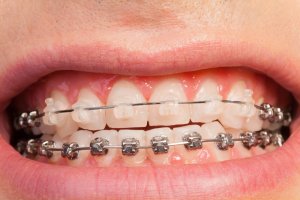

Ceramic appliances use essentially the same components as metal braces and achieve much the same results. The difference is that the material used for the brackets is a clear or tooth-colored ceramic. This means the braces blend in with the teeth and are much less obvious from a distance.
Although still noticeable close-up, they can help people feel more confident about wearing braces. Teenagers and kids avoid any “metal mouth” taunts in the playground, while adults at work might feel that clear braces make them look more professional.
One of the biggest fears orthodontic patients have, young and old, is the prospect of having a mouth full of metal. It changes your look. So if a less visibly jarring alternative to traditional metal braces exists, why aren’t ceramic braces the universal choice for treatment?
There are a few things to keep in mind about patients and their braces. Braces become part of the patient and many young patients prefer to make a choice. Metal braces are often a personal statement.
There are styles of braces: ordinary squares, stars, hearts, flowers, balls, super-diamonds and even Disney’s Mickey Mouse by WildSmiles braces. These stainless steel braces are noted for the opportunity to pick color ties to attach the wire.
Sometimes ceramic braces are offered with an extra fee. The elastic ties that hold the wire to the brackets can be stained by food and drinks and be more noticeable with ceramic braces than metal.
Another factor to consider is that it may take longer for your teeth to move into place with ceramic braces because they’re more fragile and require more care by your orthodontist.
All of that being said, ceramic braces are a great option for many patients. They get the job done and they’re less noticeable.
Dr. Clarke Stevens, Braces Omaha
Because of the more advanced materials used, usually ceramic braces cost more than metal braces. Wearers may also have to restrict what they eat in order to avoid staining the clear or white ligatures. Apart from these two things, there are no real drawbacks compared to metal braces.
In this video, one patient offers some insight into the difference between ceramic and metal braces. As you’ll see, she has clear ceramic top braces and metal braces on her bottom jaw.
Patients may get this combination of braces for financial reasons; they only pay for more expensive ceramic brackets on the top jaw, which is the most visible.
Equally, dentists might choose not to fit a ceramic appliance on the bottom jaw for practical reasons if you have a deep bite. The ceramic material is stronger than teeth, which means teeth can chip if they knock against brackets on the lower jaw. Metal brackets don’t pose this problem.
Be aware that both types (and all braces, in fact) require special attention when it comes to cleaning them and your teeth. Your dentist will show you the best tools and techniques for removing food and bacteria in tricky places. This small inconvenience is worth it to ensure your teeth don’t get stained or damaged while wearing braces.
Alternatives to ceramic braces
Invisible braces
If you’re after an even more discreet way to straighten your teeth, there is the option of invisible braces such as Invisalign and Candid. These use a different system consisting of a series of clear plastic aligners which fit over the teeth.
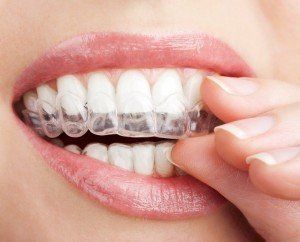

These are a great alternative to ceramic braces since they are almost completely invisible to the casual observer with the added bonus of being removable. However, you must have the self-control to wear them for 20-22 hours per day.
Invisalign treatment is suitable for 90% of orthodontic cases and the cost is usually equivalent to or lower than ceramic braces. The treatment duration is similar too, and you must visit your dentist for regular checkups. Read more about how much braces cost a month.
At-home clear aligners
At-home, or mail-order clear aligners are similar to Invisalign, except that they are 45–75% cheaper and don’t require any in-office visits. This makes them a popular choice for people who are on a budget or don’t have the time to visit their dentist every few weeks.
There are many brands available — read our separate articles including our ALIGNERCO review, NewSmile braces, and Smilelove which you can read about here. If you decide to go down this route, we recommend using a brand like NewSmile, ALIGNERCO or Candid aligners.
Check out some of the top brands below:
- Most affordable options
- Single and dual arch, day and night options
- Convenient AlignerTracker app
- Free teeth whitening
Aligner32 offers a convenient and affordable way for individuals to straighten their teeth using custom-fit clear aligners. Their service is designed for at-home use, allowing customers to avoid frequent orthodontist visits while still achieving professional-grade results.
Aligner32 provides two main treatment plans tailored to suit different needs:
- All-Day Plan: The All-Day Plan requires 22 hours of daily wear and offers faster results, with treatment lasting between 4 to 6 months.
- Night Wear Plan: The Night Wear Plan is ideal for those who prefer a more flexible routine, requiring just 10 hours of daily wear, typically at night, with a treatment duration of 6 to 8 months.
Both plans are designed to treat a range of orthodontic issues, including crowding, spacing, overbites, underbites, and crossbites.
With affordability in mind, Aligner32’s clear aligners are significantly less expensive than traditional braces, which can cost between $5,000 to $8,000. Customers can also use flexible payment plans, making it easier to manage the cost.
Additionally, Aligner32 offers a free teeth whitening kit with their aligner packages, making the treatment even more appealing. The company emphasizes comfort, convenience, and professional care, making it a popular choice for those seeking a better smile without the high costs and hassle of conventional orthodontic treatments.
- Complete treatment 100% remotely
- Amazing customer service
- Nighttime-only option
- $1,495 or $55/month
NewSmile aligners are made from the clearest Essix plastic and come with a daytime or nighttime-only option to suit you. For just $1,495 you’ll receive everything you need to straighten and whiten your teeth – and maintain your new smile:
- Home impression kit
- Full aligner treatment
- Free whitening
- First set of retainers
- A full refund if you’re not a good fit
NewSmile goes above and beyond to provide a great experience to all their customers, beginning with a live video call to help you with your teeth impressions. Mail these back, and they’ll send a 3D Treatment Preview for you to approve before going ahead.
- Smileie Pro offers hybrid treatment!
- Single-arch treatment option
- Nighttime aligners available
- Free refinements & 2 sets of retainers
- $699 (single-arch) or $999 (dual-arch)
Smileie’s aligner treatment is not only affordable, but flexible too. You have the option of Smileie Pro, which is hybrid treatment that involves in-office visits with a dentist.
That means more accurate, safer and effective treatment or a wider variety of cases.
But you can also opt for single-arch treatment for just your top or bottom teeth, as well as nighttime-only treatment. And whichever package you choose, monthly payments are available.
On top of this, Smileie offers a 100% satisfaction guarantee which includes free refinements if needed. Their aligners are made in the US and treatment takes 4-6 months on average.
Get Smileie Pro for just $1499, or —
Get the best discount on the standard plan, with 100% remote treatment, when you purchase your aligner package up-front, including:
- Home impression kit
- Teeth whitening kit
- Two sets of retainers
- A full refund if you’re not a good candidate
Packages start at $699 for single-arch treatment. Click below to check for current discounts!
- Complete treatment 100% remotely
- 4-6 month average treatment time
- Nighttime-only option
- $770 or $64/month
If you’re looking for the best value aligner package, here it is! For just $895 you’ll get:
- Impression kit
- Full aligner treatment course
- Free teeth whitening kit
- Your first set of retainers
In short, everything needed to straighten your teeth remotely and keep them looking great, with a full money-back guarantee if you’re not a suitable candidate.
This low price doesn’t mean you’re compromising on quality of care, though. ALIGNERCO just choose not to put so much into marketing, and they pass on the savings to their customers. They are also known for their responsive and helpful customer care, which is important when you’re doing things from home.
Nighttime-only aligners are also available for anyone who doesn’t want to wear aligners during the day.
At-home aligners can only be used for mild to moderate straightening. If you are interested, but you’re not ready to choose a brand, you can take a free Smile Assessment to check your eligibility.
Lingual braces
Alternatively, you might consider lingual braces. Although made from metal, they are hidden behind the teeth so are very hard to detect. They can also be completely custom-made to offer more accurate results. The downside is they usually cost a lot more than other options.
You can read more about the different types of braces in our complete guide to how much do adult braces cost?
Types of ceramic brace
Clear ceramic braces
Clear braces can be made from either plastic (polycarbonate) or ceramic. The aluminum compound most often used in clear ceramic brackets is more durable and stain-resistant than polycarbonate.
If your teeth are naturally very white, clear ceramic braces are probably the best choice for you. The transparent material practically disappears on the surface of the teeth.
Clear ceramic brackets shouldn’t stain easily, but clear ligatures might. While these are changed at every checkup, you should still take extra precautions with what you eat and drink to limit any potential for staining. You can read more about this towards the end of the article.
When compared over a longer time, metal braces are stronger than ceramic braces. Ceramic braces
frequently tend to chip off after extended use. Your orthodontist will recommend metal braces if your
therapy takes longer than average.
Dr. Yusupov, Amazing Smiles Orthodontics
White ceramic braces
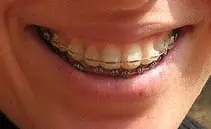

Despite being referred to as ‘white’, these braces are actually designed to be tooth-colored. If they were pure white, they would just draw attention to the fact that our teeth are naturally a bit yellow. But ‘off-white ceramic braces’ doesn’t sound as good, does it?
White ceramic braces look best against teeth that are a slightly darker shade.
A different aluminum compound is used to create the whitish color of these brackets. With certain brands, it’s possible to get brackets made to match the shade of your teeth. Others come in standard shades that may not be an exact match.
As with clear braces, the brackets themselves won’t stain but the elastics do.
Colored ceramic braces
Although many people choose ceramic fixed braces because they want them to be as inconspicuous as possible, there’s nothing to stop you from jazzing them up with colored ligatures. Just like colored metal braces, you can personalize them by choosing from a range of colored elastics. Especially when it comes to ceramic braces for kids, youngsters may want the option of having color.
Ligatures are replaced at every visit so you’ll have plenty of chances to change your look.
Ceramic brace brands in the US
Different dentists choose to work with different brands of braces for different reasons. For instance, things like the cost, availability, quality, comfort, ease of fitting and removal, or customer service may influence their decision.
Some of the most common brands of ceramic brace available in the US include:
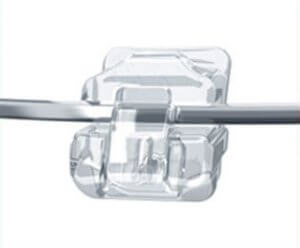

- Damon Clear
- Radiance Plus
- Clarity (ADVANCED and SL)
- InVu
Most dentists offer just one brand – possibly two. If you are set on a specific brand for whatever reason, you may need to look beyond your local clinic.
Below is a brief overview of the features and unique aspects of these brands:
Damon Clear
Damon Clear braces use a self-ligating system which eliminates elastic ties – meaning they are unlikely to stain. Many patients find self-ligating braces more comfortable as teeth move gradually under constant pressure, rather than braces being tightened in stages.
This system may also result in a slightly reduced treatment time and fewer checkups along the way. This makes them a popular choice for people who want faster results with a convenient schedule.
Radiance Plus
Radiance braces, from American Orthodontics, are extremely strong since they are made of sapphire (the next strongest thing to diamond). With their glass-like appearance, many dentists say they are the clearest braces available on the market. It shouldn’t come as a surprise they are also one of the most costly.
Clarity
The Clarity system from 3M uses translucent tooth-colored brackets which are specially designed for comfort and ease of removal when treatment is complete. They have standard and self-ligating options.
InVu


These braces are not only tooth-colored; they are made to match the color of your teeth. They also come with tooth-colored wires as standard. This is a metal wire coated in Teflon, so it’s possible for the coating to chip or become scratched, revealing the metal underneath.
What do ceramic braces cost?
There is no fixed cost for any kind of private dental treatment since every dentist is free to set their own prices. However, the following is a rough guide to what different brands of ceramic braces cost in the US.
Type of braces | Cost per arch | Material | Self-ligating? |
Damon Clear | $1,900 – $4,000 | Clear | Yes |
Radiance Plus | $2,500 – $5,000 | Clear | Yes |
Clarity ADVANCED | $2,200 – $4,700 | Translucent tooth-colored | No |
Clarity SL | $2,500 – $5,000 | Translucent tooth-colored | Yes |
InVu | $2,300 – $4,300 | Translucent tooth-colored | No |
These prices are indicative only. We recommend you get quotes from 2-3 dentists if possible. This will give you a better idea of prices in your area for the treatment you need.
Ceramic brace treatment in the US is often covered by dental insurance plans. You’ll need to check the percentage allowance and annual limits in your policy to discover how much of the cost will actually be reimbursed. Chances are you’ll still need to pay a large chunk of it yourself. Read more about the best dental insurance plans in the US.
Life with ceramic braces
In many ceramic braces reviews, wearers report feeling less self-conscious about wearing this style of braces.
But remember that these braces are still visible to some degree. Because people are less familiar with clear and white braces, they may actually take a longer glance at your mouth to work out what is in there. With metal braces, on the other hand, there is less curiosity.
Braces pain
Braces can cause discomfort, and some people feel pain simply due to teeth readjusting. Dental wax can provide some relief from the edges of brackets, and cold foods and over-the-counter pain relievers can also help ease those aches.
Do ceramic braces stain?
The material used for the brackets is designed to be stain-resistant. However, there is a possibility that the elastic bands placed on each bracket will become stained from certain foods and drinks.
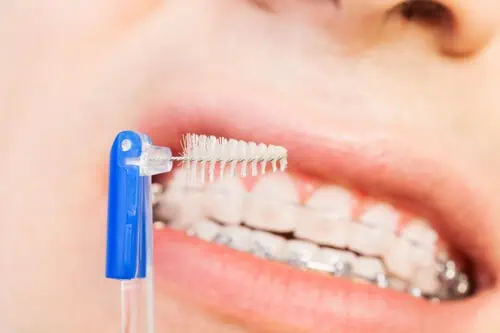

If you’re paying the extra for ceramic fixed braces that blend in with your teeth, it’s worth making an effort to keep them that way. This means brushing and rinsing your teeth after every meal and flossing every day. Your dentist can advise you on the best tools to clean between and around your braces, as well as flossing with braces.
You’ll also want to avoid or limit your consumption of foods and drinks that can cause ligatures to stain. These include:
- Coffee and tea
- Red wine
- Dark-colored sodas like cola
- Tomatoes and tomato-based sauces
- Brightly-colored candies
- Soy sauce and balsamic vinegar
- Curries
- Berries such as raspberries, blueberries, and blackberries
This is in addition to any foods your dentist tells you to avoid in order to protect your braces (usually chewy, crunchy, and hard foods). Smoking will also stain your braces (and cause general oral health issues) so if you’re a smoker, try to quit.
If your ligatures do become discolored, you’ll only have to live with it for a few weeks as they are changed at every visit. Make sure you keep up with your appointment schedule – the longer you leave in between visits, the greater the chance of staining.
Of course, if you choose a self-ligating appliance, you won’t have any ligatures to worry about. Cleaning as advised by your dentist should be enough to stop the brackets and wire from staining.
Teeth whitening
If you’re planning to get your teeth whitened to complete the aesthetics of your smile, it’s best to wait until after your braces are removed. This is because the whitening agent won’t reach the areas where the brackets are bonded and you’ll be left with a darker spot on each tooth.
Similarly, whitening toothpaste should be avoided while you’re wearing braces.
Conclusion
If you’re deciding between ceramic and metal braces your choice will come down to cost and aesthetics since they both function in the same way. However, if you haven’t already considered invisible braces, you may find that these are an even better solution for your needs.
These clear aligners are practically invisible so most people won’t know you’re wearing braces at all. Just keep in mind that they are only meant for mild to moderate straightening.







